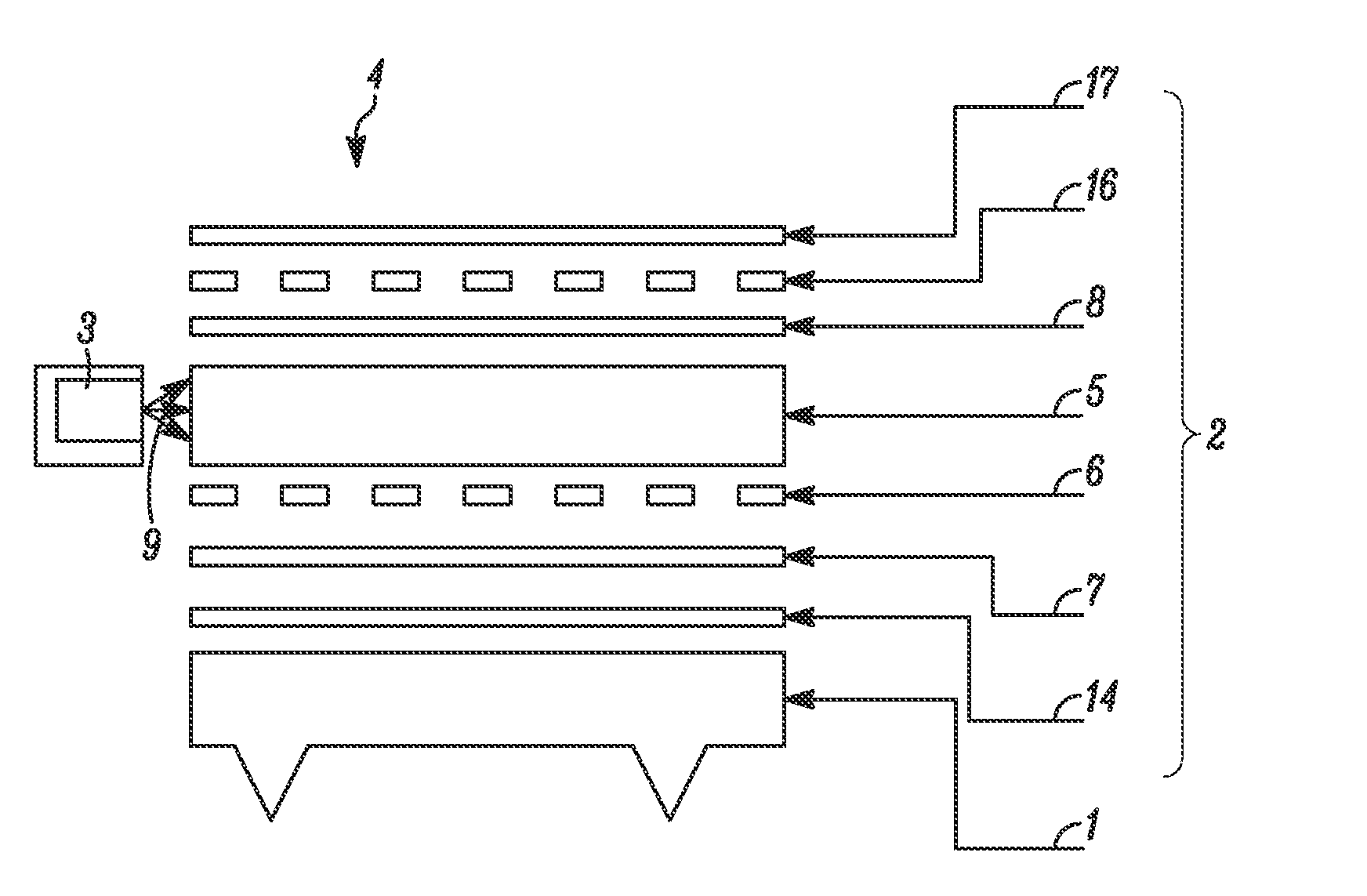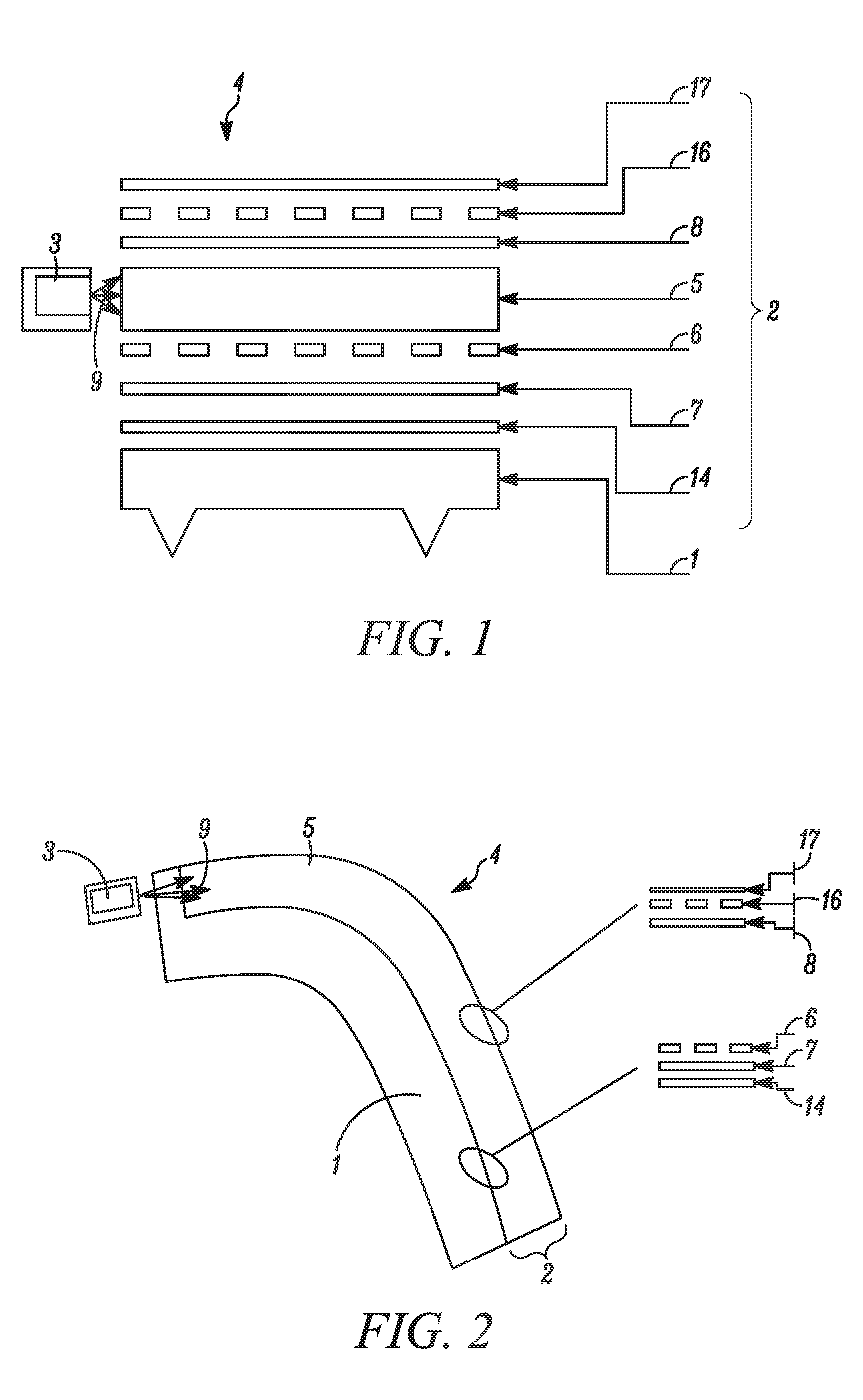Equipment part having luminous visible side
a technology of equipment parts and visible sides, applied in the field of equipment parts, can solve the problems of limiting the use of light guides on equipment parts, affecting the quality of light guides, and affecting the appearance of equipment parts, so as to prevent damage to the composite film, improve the melting point, and ensure the effect of joint reliability
- Summary
- Abstract
- Description
- Claims
- Application Information
AI Technical Summary
Benefits of technology
Problems solved by technology
Method used
Image
Examples
first embodiment
[0048]FIG. 2 shows a sectional view of an equipment part according to the present disclosure. The equipment part can include a transparent carrier 1 which may be made of polycarbonate, on which the composite film 2 can be disposed. The contour of the equipment part may be predefined by the carrier 1. The composite film 2 can have an overall thickness of 1.9 mm and may conform to the curves of the contour of the carrier 1. The light-conducting properties or the outcoupling behavior of the incoupled light rays 9 may not be impaired here. In the shown embodiment, the homogeneous outcoupling behavior may be additionally supported by a scatter layer 6, where the scatter layer 6 may have a surface structure that differs in various regions of the composite film. For example, the scatter layer 6 can have a considerably less pronounced surface structure in the curvature of the equipment part than in the planar regions.
[0049]Like the carrier 1, the light-conducting layer 5 of the composite fi...
second embodiment
[0050]FIG. 3 shows a sectional view of the equipment part according to the present disclosure. The carrier 1 can be made of non-transparent polypropylene. In addition to polycarbonate and polypropylene, it is also possible to use other plastic materials, such as polyethylene, polymethyl methacrylate or acrylonitrile butadiene styrene, for example, for forming the carrier. In this embodiment, the light rays 9 of the light source 3 may be no longer able to penetrate the carrier 1, so the carrier 1 can be removed in an end-face region of the composite film 2 using a milling cutter. However, the material removal can also be carried out by way of drilling, cutting, or other comparable material-removing processes. The composite film 2 may comprise a white protective coating 14. Plastic material that has a sufficiently low melting temperature may be used, and the protective coating 14 may thereby be dispensed with. If the carrier 1 is additionally dyed in a white color or in another easily...
third embodiment
[0052]FIG. 4 shows an equipment part according to the present disclosure. The equipment part may have an edge folding, so that an undercut region can be created, which may not be visible to the observer of the equipment part. Such a design may be necessary, for example, if additional equipment parts directly adjoin the equipment part. It can therefore be avoided that potential gaps or even omissions between the equipment parts are visible. Moreover, such an edge folding may be provided for attaching the equipment part. An opening 13 can be introduced into the composite film 2, which may serve an incoupling point for the light source 3. For this purpose, the second paint layer 8, the imprint 16, and the protective layer 17 can be completely removed in the undercut region. Moreover, a step, which may form the opening 13, can be introduced into the light-conducting layer 5 with the aid of a milling process, for example. The light source 3 may moreover be provided directly in front of t...
PUM
| Property | Measurement | Unit |
|---|---|---|
| thickness | aaaaa | aaaaa |
| thickness | aaaaa | aaaaa |
| thickness | aaaaa | aaaaa |
Abstract
Description
Claims
Application Information
 Login to View More
Login to View More - R&D
- Intellectual Property
- Life Sciences
- Materials
- Tech Scout
- Unparalleled Data Quality
- Higher Quality Content
- 60% Fewer Hallucinations
Browse by: Latest US Patents, China's latest patents, Technical Efficacy Thesaurus, Application Domain, Technology Topic, Popular Technical Reports.
© 2025 PatSnap. All rights reserved.Legal|Privacy policy|Modern Slavery Act Transparency Statement|Sitemap|About US| Contact US: help@patsnap.com



